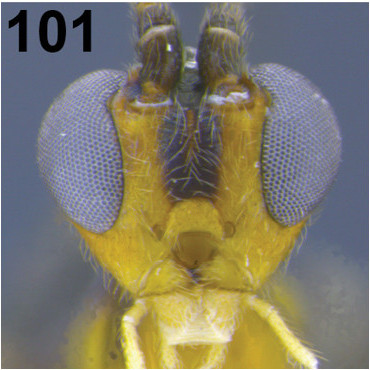|
Brachistinae
Brachistinae is a subfamily of braconid wasps in the family Braconidae. The genera of Brachistinae were formerly classified under the subfamily Blacinae, which became the tribe Blacini, and tribes Diospilini, Brulleiini and Brachistini of the subfamily Helconinae. Genera The genera of the subfamily Brachistinae include: * ''Aspicolpus'' Wesmael, 1838 * ''Aspigonus'' Wesmael, 1835 * ''Baeacis'' Förster, 1878 * ''Blacometeorus'' Tobias, 1976 * ''Blacus'' Nees von Esenbeck, 1818 * ''Brulleia'' Szépligeti, 1904 * ''Diospilus'' Haliday, 1833 * ''Dyscoletes'' Westwood, 1840 * ''Eubazus'' Nees von Esenbeck, 1812 * ''Foersteria (wasp), Foersteria'' Szépligeti, 1896 * ''Nipponocolpus'' Belokobylskij & Fujie, 2017 * ''Parabrulleia'' van Achterberg, 1983 * ''Schizoprymnus'' Förster, 1862 * ''Taphaeus'' Wesmael, 1835 * ''Triaspis (wasp), Triaspis'' Haliday, 1838 * ''Vadumasonium'' Kammerer, 2006 * ''Xyeloblacus'' van Achterberg, 1997 c g Data sources: i = ITIS, c = Catalogue of Life, ... [...More Info...] [...Related Items...] OR: [Wikipedia] [Google] [Baidu] |
Blacini
Blacini is a Tribe (biology), tribe of braconid Parasitoid wasps. Formerly the subfamily Blacinae, this group was demoted to a tribe and placed within the Brachistinae based on molecular evidence in 2011. Description and distribution Members of this tribe are tiny and generally black or brown in color. They have non-cyclostome mouthparts and a carina, or ridge, along the back of the head. These wasps have a worldwide distribution. The genus ''Blacus'' is by far the most common and has a cosmopolitan range, with about 40 described species in the New World. The other genera are more restricted, and mostly found in South and Central America. Biology Little is known about the biology of species within Blacini, but ''Blacus'' species are known to be parasitoids of beetle larvae. Two species of the genus ''Dyscoletes'' Halyday are parasitoids of ''Boreus'' larvae. Males of some ''Blacus'' species are known to form mating swarms. Species These genera are members of the tribe Blacini: ... [...More Info...] [...Related Items...] OR: [Wikipedia] [Google] [Baidu] |
Braconid Wasp
The Braconidae are a family of parasitoid wasps. After the closely related Ichneumonidae, braconids make up the second-largest family in the order Hymenoptera, with about 17,000 recognized species and many thousands more undescribed. One analysis estimated a total between 30,000 and 50,000, and another provided a narrower estimate between 42,000 and 43,000 species. Classification The Braconidae are currently divided into about 47 subfamilies and over 1000 genera, which include ''Aerophilus'', ''Aleiodes'', ''Apanteles'', ''Asobara'', ''Bracon (genus), Bracon'', ''Cenocoelius'', ''Chaenusa'', ''Chorebus'', ''Cotesia'', ''Dacnusa'', ''Diachasma'', ''Microgaster'', ''Opius'', ''Parapanteles'', ''Phaenocarpa'', ''Spathius'', and ''Syntretus.'' These fall into two major groups, informally called the cyclostomes and noncyclostomes. In cyclostome braconids, the Labrum (arthropod mouthpart), labrum and the lower part of the Clypeus (arthropod anatomy), clypeus are concave with respect ... [...More Info...] [...Related Items...] OR: [Wikipedia] [Google] [Baidu] |
Braconidae
The Braconidae are a family of parasitoid wasps. After the closely related Ichneumonidae, braconids make up the second-largest family in the order Hymenoptera, with about 17,000 recognized species and many thousands more undescribed. One analysis estimated a total between 30,000 and 50,000, and another provided a narrower estimate between 42,000 and 43,000 species. Classification The Braconidae are currently divided into about 47 subfamilies and over 1000 genera, which include ''Aerophilus'', ''Aleiodes'', '' Apanteles'', ''Asobara'', '' Bracon'', ''Cenocoelius'', '' Chaenusa'', ''Chorebus'', '' Cotesia'', '' Dacnusa'', '' Diachasma'', ''Microgaster'', ''Opius'', ''Parapanteles'', '' Phaenocarpa'', ''Spathius'', and ''Syntretus.'' These fall into two major groups, informally called the cyclostomes and noncyclostomes. In cyclostome braconids, the labrum and the lower part of the clypeus are concave with respect to the upper clypeus and the dorsal margin of the mandibles. The ... [...More Info...] [...Related Items...] OR: [Wikipedia] [Google] [Baidu] |
Triaspis (wasp)
''Triaspis'' is a genus of braconid wasps in the family Braconidae The Braconidae are a family of parasitoid wasps. After the closely related Ichneumonidae, braconids make up the second-largest family in the order Hymenoptera, with about 17,000 recognized species and many thousands more undescribed. One analysis .... There are at least 110 described species in ''Triaspis''. See also * List of Triaspis species References Further reading * * * Parasitic wasps {{ichneumonoidea-stub ... [...More Info...] [...Related Items...] OR: [Wikipedia] [Google] [Baidu] |
Foersteria (wasp)
''Breynia'' is a plant genus in the family Phyllanthaceae, first described in 1776. It is native to Southeast Asia, China, the Indian Subcontinent, Papuasia, Australia, and the island of Réunion. The name ''Breynia'' is a conserved name, it is recognized despite the existence of an earlier use of the same name to refer to a different plant. ''Breynia'' L. 1753 is in the Capparaceae, but it is a rejected name. We here discuss ''Breynia'' J.R.Forst. & G.Forst. 1776. In a 2006 revision of the Phyllanthaceae, it was recommended that ''Breynia'' be subsumed in ''Phyllanthus''; however, new combinations in ''Phyllanthus'' for former ''Breynia'' species remain to be published. ''Breynia'' are of special note in the fields of pollination biology and coevolution because they have a specialized mutualism with moths in the genus ''Epicephala'' (leafflower moths), in which the moths actively pollinate the flowers—thereby ensuring that the tree may produce viable seeds—but also lay ... [...More Info...] [...Related Items...] OR: [Wikipedia] [Google] [Baidu] |
Eubazus
''Eubazus'' is a genus of braconid wasps in the family Braconidae The Braconidae are a family of parasitoid wasps. After the closely related Ichneumonidae, braconids make up the second-largest family in the order Hymenoptera, with about 17,000 recognized species and many thousands more undescribed. One analysis .... There are at least 140 described species in ''Eubazus''. See also * List of Eubazus species References Further reading * * * External links * Parasitic wasps {{ichneumonoidea-stub ... [...More Info...] [...Related Items...] OR: [Wikipedia] [Google] [Baidu] |



.jpg)
